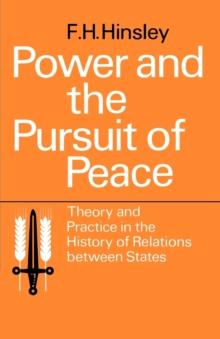
POWER AND THE PURSUIT OF PEACE: THEORY AND PRACTICE IN THE HISTORY OF RELATIONS BETWEEN STATES
POWER AND THE PURSUIT OF PEACE: THEORY AND PRACTICE IN THE HISTORY OF RELATIONS BETWEEN STATES
Εκδόσεις:
Cambridge
In the last years of the nineteenth century peace proposals were first stimulated by fear of the danger of war rather than in consequence of its outbreak. In this study of the nature and history of international relations Mr Hinsley presents his conclusions about the causes of war and the development of mens efforts to avoid it. In the first part he examines international theories from the end of the middle ages to the establishment of the League of Nations in their historical setting. This enables him to show how far modern peace proposals are merely copies or elaborations of earlier schemes. He believes there has been a marked reluctance to test these theories not only against the formidable criticisms of men like Rousseau, Kant and Bentham, but also against what we have learned about the nature of international relations and the history of the practice of states. This leads him to the second part of his study - an analysis of the origins of the modern states system and of its evolution between the eighteenth century and the First World War.
Περιγραφή

Λεπτομέρειες

ISBN:
978-0-521-09448-1
Barcode:
9780521094481
Εκδότης:
Cambridge
Συντελεστές:
Συγγραφέας
F.H. Hinsley
Εξώφυλλο:
Paperback
Σελίδες:
428
Αποστολή & Πάραδοση

Παραλαβή από κατάστημα
Παραλαβή από κατάστημα
Παραλαμβάνεται την παραγγελία σας από το κατάστημά μας επί της οδού Στ.Τσαλαβούτα 3, 12131, Περιστέρι.
Courier
Courier
Αποστέλεται με την εταιρεία ACS ή Γενική Ταχυδρομική εντός μιας εργάσιμης.
Διαθέσιμο σε 1 εργάσιμες
25.8€
25.80€


Μάθετε πρώτοι τα νέα μας
και τις προσφορές μας.
Ανώνυμη Εταιρεία Διακίνησης
Εμπορίας και Έκδοσης Βιβλίων
 Στ. Τσαλαβούτα 3, Τ.Κ. 12131, Αθήνα - Ελλάδα
Στ. Τσαλαβούτα 3, Τ.Κ. 12131, Αθήνα - Ελλάδα 211 104 1980
211 104 1980 [email protected]
[email protected]
powered by
 engine
🛠20220629.154231
engine
🛠20220629.154231
 engine
🛠20220629.154231
engine
🛠20220629.154231


